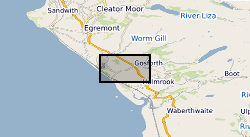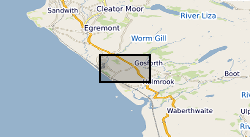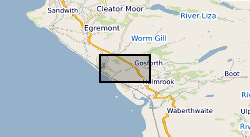Deep drilling
Type of resources
Topics
Keywords
Contact for the resource
Provided by
Years
Formats
Representation types
Update frequencies
Scale
-

During the period from 1989 to 1997, Nirex undertook extensive geological investigations at sites near Sellafield, in Cumbria, and Dounreay, in Caithness, to examine whether or not they were suitable locations for a deep repository for radioactive waste. At Sellafield, thirty deep boreholes, and a further thirty-five shallow boreholes, were drilled. The majority of the deep boreholes were drilled to obtain continuous core and some 18.7km of rock core arose from the investigations. Two deep boreholes were drilled at Dounreay, totalling 2,286 metres of drilling. Again, much of the drilling was to obtain continuous core. In most of the boreholes a suite of data acquisition techniques were used, including: continuous coring, geophysical wireline logging, hydraulic testing, sampling and analysis of groundwaters. Mineralogical data were acquired by detailed core observation, petrographic analysis, fluid inclusion analysis and stable and radiogenic isotope studies. Testing on samples from the rock cores was undertaken to determine petrological, mineralogical, hydrogeological, geophysical and geotechnical parameters. The ownership of NIREX (Nuclear Industry Radioactive Waste Executive) was transferred from the nuclear industry to the UK Government departments DEFRA and DTI in April 2005, and then to the UK's Nuclear Decommissioning Authority (NDA) in November 2006.
-

As an integral part of the investigations carried out at Sellafield, and to a lesser extent for the Dounreay boreholes, the cores from the boreholes were systematically examined by geologists and samples selected for detailed petrographic analysis. Thin sections were prepared from many of these samples. Some of the samples were then prepared for analysis using X-ray fluorescence, X-ray diffraction or scanning electron microscopy. Samples containing fluid inclusions were prepared as doubly polished fluid inclusion wafers. Thin sections were prepared from soil materials obtained from the investigations of the Quaternary deposits. Particular attention was given to samples of the mineralisation that was identified in the formations at Sellafield. In addition to the samples from the boreholes, there are also some samples obtained from surface exposures that were examined during the regional surveys. The samples and sections have been catalogued and incorporated into the national collection by the British Geological Survey. The ownership of NIREX (Nuclear Industry Radioactive Waste Executive) was transferred from the nuclear industry to the UK Government departments DEFRA and DTI in April 2005, and then to the UK's Nuclear Decommissioning Authority (NDA) in November 2006.
-

A significant part of this data collection is geophysical survey data in digital form, being mainly instrumental recordings made during fieldwork. Derived data created during the subsequent processing and interpretation of the field data is described in 'Nirex Magnetic Tape Archives - Processed Data'. These data were originally stored on a variety of media. With the overall aim of delivering an efficient and effective archive service, the data have been consolidated onto DLT cartridges. Some related data, which were either analogue, on obscure media or in unknown formats have been retained in their original form. British Geological Survey maintains a full catalogue of the data, as an Access database.The data sets that comprise the magnetic archive are the following: Seismic surveys: marine, land and transition zone; field, navigation, statiatcs; Geophysical wireline logging of boreholes: routine wireline logging of investigation boreholes (gamma-ray, sonic, porosity, etc.); velocity surveys; dipmeter surveys;vertical seismic profiling; borehole televiewer (BHTV) surveys; formation microscanner (FMS) surveys; Ground surveys: magnetic; gravity; radiometric; thermal imaging; photographic imaging; in-flight videos. The ownership of NIREX (Nuclear Industry Radioactive Waste Executive) was transferred from the nuclear industry to the UK Government departments DEFRA and DTI in April 2005, and then to the UK's Nuclear Decommissioning Authority (NDA) in November 2006.
-

During the interpretation of the geological structure of the Sellafield site, a series of 3-D models were created using EarthVision and Vulcan software. These models have been imported into the computer systems operated by British Geological Survey. Geological investigations of the Sellafield and Dounreay areas were undertaken between 1989 and 1997 as part of its programme to determine whether one of the areas might be a suitable location of a deep repository for the disposal of radioactive waste. The Nirex (Nuclear Industry Radioactive Waste Executive) Geological Archive was deposited with BGS in 2000 and BGS have undertaken to retain the records for a minimum of 50 years as part of its national geological archive. The archive has been moved to permanent storage locations and normal BGS arrangements will apply for non-commercial (academic) access to the material. The ownership of NIREX (Nuclear Industry Radioactive Waste Executive) was transferred from the nuclear industry to the UK Government departments DEFRA and DTI in April 2005, and then to the UK's Nuclear Decommissioning Authority (NDA) in November 2006.
-

The paper archives comprise a set of the factual and interpretative reports that document the investigations carried out by Nirex (Nuclear Industry Radioactive Waste Executive) and its contractors. In total there are in excess of 2,250 individual volumes. It is the availability of this paper archive of results and interpretation that makes the Nirex geological archives of rock cores and samples unique. The ownership of NIREX (Nuclear Industry Radioactive Waste Executive) was transferred from the nuclear industry to the UK Government departments DEFRA and DTI in April 2005, and then to the UK's Nuclear Decommissioning Authority (NDA) in November 2006.
 NERC Data Catalogue Service
NERC Data Catalogue Service